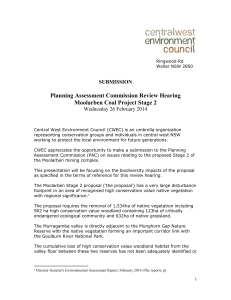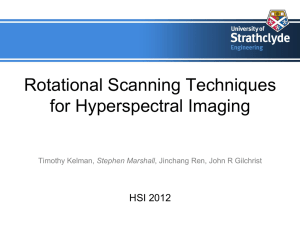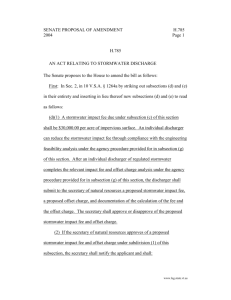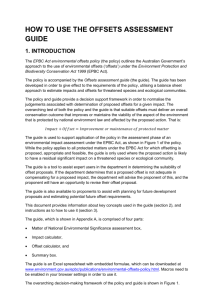Remnant patch offset management plan [MS Word Document
advertisement
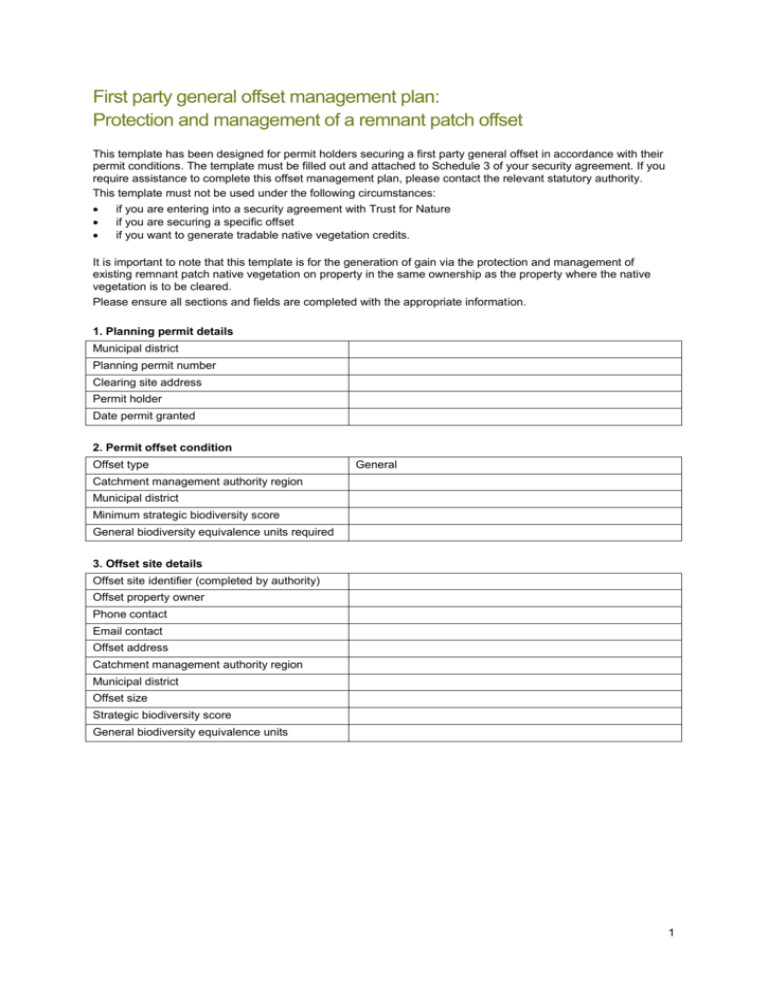
First party general offset management plan: Protection and management of a remnant patch offset This template has been designed for permit holders securing a first party general offset in accordance with their permit conditions. The template must be filled out and attached to Schedule 3 of your security agreement. If you require assistance to complete this offset management plan, please contact the relevant statutory authority. This template must not be used under the following circumstances: if you are entering into a security agreement with Trust for Nature if you are securing a specific offset if you want to generate tradable native vegetation credits. It is important to note that this template is for the generation of gain via the protection and management of existing remnant patch native vegetation on property in the same ownership as the property where the native vegetation is to be cleared. Please ensure all sections and fields are completed with the appropriate information. 1. Planning permit details Municipal district Planning permit number Clearing site address Permit holder Date permit granted 2. Permit offset condition Offset type General Catchment management authority region Municipal district Minimum strategic biodiversity score General biodiversity equivalence units required 3. Offset site details Offset site identifier (completed by authority) Offset property owner Phone contact Email contact Offset address Catchment management authority region Municipal district Offset size Strategic biodiversity score General biodiversity equivalence units 1 4. Offset area A first party general offset condition may be satisfied by securing more than one individual site. If those multiple sites are in the same proximity within the same property, they can be combined in the same management plan. Sites separated by great distances need to use individual management plans, but can be secured on the same security agreement. Total area(ha) of offset Number of separate sites on management plan to satisfy permit condition. Area(ha) of site 1 Area(ha) of site 2 5. Security agreement Statutory body Agreement type 6. Ongoing security and management commitment standards The landowner must comply with the security agreement identified in Section 4 and meet all of the following ongoing management commitments to achieve the predicted gain from the offset site. The management commitments are set out in detail below: a) retain all standing trees (dead or alive) b) exclude stock and other threats c) ensure weed cover (both Catchment and Land Protection Act 1994 (CaLP Act) and non CaLP Act weeds) does not increase beyond the current level d) monitor for any new and emerging weeds (both CaLP Act and non CaLP Act weeds) and eliminate to <1 per cent cover e) retain logs and fallen timber f) retain organic litter g) control rabbits. The landowner(s), and any future landowner(s), of the site are required to maintain the condition of the offset site to the level achieved at the conclusion of the ten year management plan in perpetuity. a) Retain all standing trees (dead or alive) The removal of dead and living standing trees is prohibited. Suggested management actions none required b) Exclude stock and other threats A map of where fencing is to be erected on the site, as well as and the timing of fencing placement (if required) must be recorded in Table 2. Unless alternative fencing methods have been agreed upon to the satisfaction of DEPI, the commitment must be achieved in accordance with the Native vegetation credit register management standard – Fencing, which includes the following: stock are not permitted to enter the site where there is a risk of stock entering the site it must be fenced at that time to the following standard: o six line ring-lock with one plain wire or five strand plain wire with two electrified strands or seven strand plain wire o 1.8m high treated pine or steel post with posts no more than 10m apart with two droppers in between o trainers 2.1m high, 150mm wide treated pine or railway iron/large diameter steel pots o stays 3m treated pine fences do not include barbed wire fences are not electrified on the bottom strand along waterways fences are a minimum of 10m from the top edge of the bank around scattered trees the fence protects an area twice the diameter of the drip line of the tree motorised vehicles, bikes and horses are not permitted to enter the site. Formed tracks or trails through patches of native vegetation must not be included in the boundaries of sites. The landowner must manage 2 the site so that motorised vehicles, bikes and horses do not enter the site from these tracks or trails. This may require construction of barriers along the edge of the track or trail alternative fencing specifications may be agreed with the security agreement’s statutory authority provided the alternative method achieves the commitment. Suggested management actions erect a new fence around the perimeter of the site. upgrade fencing around the perimeter of the site. maintain fencing around boundary of the site in good condition. if a threat arises, erect a fence around the perimeter of the site. c) Ensure weed cover does not increase beyond the current level The current overall percentage cover of weeds within the offset site must be recorded in Table 1. The methods and timing used to control the weeds must be recorded within Table Table 2. The commitment must be achieved in accordance with the Native vegetation credit register management standard – Control or elimination of weeds, which includes the following: control all weeds to ensure that their overall cover does not increase beyond level specified in the premanagement site condition table (Table 1) prior to commencement of the plan. Suggested management actions felling/ring barking cut and paint with suitable herbicide drill or frill and fill with suitable herbicide spot-praying and wick-wiping slashing and mowing hand weeding spot-burning grazing d) Monitor for any new and emerging weeds and eliminate to <1 per cent cover The commitment must be achieved in accordance with the Native vegetation credit register management standard – Control or elimination of weeds. eliminate any new and emerging weeds so that their cover is negligible. Suggested management action same as previous commitment e) Retain fallen logs and timber Collecting any fallen logs or timber is prohibited. Suggested management actions none required f) Retain organic litter All organic litter must remain within the boundaries of the offset site. Suggested management actions none required g) Control rabbits The methods and timing of control must be recorded in Table 3. The commitment must be achieved in accordance with the following Native vegetation credit register management standard – Rabbit control, which includes the following: 3 remove surface harbour o remove all surface harbour. Note that this excludes indigenous plants, fallen logs and rocks o remove any surface harbour identified in site inspections by the organisation monitoring compliance with the security agreement. hand collapsing warrens (with or without fumigation) o hand collapse warrens so that they are no longer used by rabbits o hand collapse any warrens identified in site inspections by the organisation monitoring compliance with the security agreement, so that they are no longer used by rabbits. baiting o create bait trails using handheld equipment. Apply baits at timing specified in Table 2. Dispose of rabbit carcasses after baiting to reduce risk of off target poisoning. Suggested management actions burrow fumigation and hand collapse rabbit proof fencing removal of harbour baiting 7. Offset site condition and management actions Landowners are required to record the condition of the offset site in Table 1 prior to implementing the management plan. Landowners must record the offset site’s current condition concerning: current percentage of all standing trees (dead and alive) coverage threat of stock invasion current percentage of weed coverage current percentage of logs and fallen timber coverage presence of organic litter current state of rabbit presence. Landowners are required to complete the management plan in Table 2 by indicating: which management actions will be undertaken for each management commitment the timing for each management action. 8. Reporting The security agreement requires the landowner to submit a yearly site condition report for each year of the ten year management plan and thereafter at the reasonable request of the statutory authority. Reports are to be submitted prior to the anniversary date of the execution of the agreement.. The yearly site condition report must address progress against each management commitment set out in this agreement. Landowners must submit photographs which clearly depict management actions undertaken for the previous year. The following must be included in the yearly site condition report: permit holder planning permit number site identifier reporting year (1-10) date report is submitted who completed the report condition of site against each management commitment actions taken during the year to achieve the management commitment provide photographs. The yearly site condition report template can be found on DEPI’s website. 4 Pre-management site condition Table 1: Current offset site condition Commitment Pre-management plan condition* Current percentage of all standing trees (dead and alive) coverage Exclude stock and other threats Current percentage of weed coverage Monitor for any new and emerging weeds and eliminate to <1 per cent cover Not applicable Current percentage of logs and fallen timber coverage Presence of organic litter Current level of rabbit presence 5 Management plan Table 2: 10 year management actions and implementation schedule Year(s) Commitment to be achieved 1 Exclude stock and other threats 1 Control rabbits 1-10 Ensure weed cover does not increase beyond initial recorded level 1-10 Monitor and report 2-10 Exclude stock and other threats 2-10 Control rabbits 2-10 Monitor for any new and emerging weeds and eliminate to <1 cover Management action to be undertaken Timing of management action 6 9. Declaration Landowner Name: ____________________________________________________ Signature:_____________________________ Date: ______________ Statutory authority officer Name:_____________________________________________________ Title:______________________________________________________ Signature:_____________________________ Date: _______________ 7




